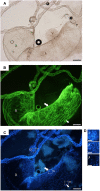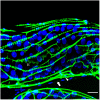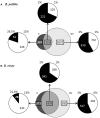Gall Wasp Transcriptomes Unravel Potential Effectors Involved in Molecular Dialogues With Oak and Rose
- PMID: 31396099
- PMCID: PMC6667641
- DOI: 10.3389/fphys.2019.00926
Gall Wasp Transcriptomes Unravel Potential Effectors Involved in Molecular Dialogues With Oak and Rose
Abstract
To gain insight into wasp factors that might be involved in the initial induction of galls on woody plants, we performed high throughput (454) transcriptome analysis of ovaries and venom glands of two cynipid gall wasps, Biorhiza pallida and Diplolepis rosae, inducing galls on oak and rose, respectively. De novo assembled and annotated contigs were compared to sequences from phylogenetically related parasitoid wasps. The relative expression levels of contigs were estimated to identify the most expressed gene sequences in each tissue. We identify for the first time a set of maternally expressed gall wasp proteins potentially involved in the interaction with the plant. Some genes highly expressed in venom glands and ovaries may act to suppress early plant defense signaling. We also identify gall wasp cellulases that could be involved in observed local lysis of plant tissue following oviposition, and which may have been acquired from bacteria by horizontal gene transfer. We find no evidence of virus-related gene expression, in contrast to many non-cynipid parasitoid wasps. By exploring gall wasp effectors, this study is a first step toward understanding the molecular mechanisms underlying cynipid gall induction in woody plants, and the recent sequencing of oak and rose genomes will enable study of plant responses to these factors.
Keywords: gall induction; oak gall wasp; ovary secretions; rose gall wasp; venom.
Figures







Similar articles
-
Genomic dissection of an extended phenotype: Oak galling by a cynipid gall wasp.PLoS Genet. 2019 Nov 4;15(11):e1008398. doi: 10.1371/journal.pgen.1008398. eCollection 2019 Nov. PLoS Genet. 2019. PMID: 31682601 Free PMC article.
-
The enemy hypothesis: correlates of gall morphology with parasitoid attack rates in two closely related rose cynipid galls.Bull Entomol Res. 2013 Jun;103(3):326-35. doi: 10.1017/S0007485312000764. Epub 2012 Dec 7. Bull Entomol Res. 2013. PMID: 23217451
-
Plant Gall Diversity in Burned Semi-natural Grasslands in Japan.J Insect Sci. 2023 Jan 1;23(1):5. doi: 10.1093/jisesa/iead005. J Insect Sci. 2023. PMID: 36729095 Free PMC article.
-
A catalogue, revision, and regional perspective of Eastern Palaearctic and Oriental oak gall wasps and their inquilines (Hymenoptera: Cynipidae: Cynipini, Synergini, Ceroptresini).Zootaxa. 2022 Jul 4;5161(1):1-71. doi: 10.11646/zootaxa.5161.1.1. Zootaxa. 2022. PMID: 36095527 Review.
-
The population biology of oak gall wasps (Hymenoptera: Cynipidae).Annu Rev Entomol. 2002;47:633-68. doi: 10.1146/annurev.ento.47.091201.145247. Annu Rev Entomol. 2002. PMID: 11729087 Review.
Cited by
-
From Inquilines to Gall Inducers: Genomic Signature of a Life-Style Transition in Synergus Gall Wasps.Genome Biol Evol. 2020 Nov 3;12(11):2060-2073. doi: 10.1093/gbe/evaa204. Genome Biol Evol. 2020. PMID: 32986797 Free PMC article.
-
New Gall-Forming Insect Model, Smicronyx madaranus: Critical Stages for Gall Formation, Phylogeny, and Effectiveness of Gene Functional Analysis.Insects. 2024 Jan 16;15(1):63. doi: 10.3390/insects15010063. Insects. 2024. PMID: 38249069 Free PMC article.
-
Florigen and its homologs of FT/CETS/PEBP/RKIP/YbhB family may be the enzymes of small molecule metabolism: review of the evidence.BMC Plant Biol. 2022 Jan 27;22(1):56. doi: 10.1186/s12870-022-03432-z. BMC Plant Biol. 2022. PMID: 35086479 Free PMC article. Review.
-
Recent Progress Regarding the Molecular Aspects of Insect Gall Formation.Int J Mol Sci. 2021 Aug 30;22(17):9424. doi: 10.3390/ijms22179424. Int J Mol Sci. 2021. PMID: 34502330 Free PMC article. Review.
-
Comprehensive phylogenomic analyses re-write the evolution of parasitism within cynipoid wasps.BMC Evol Biol. 2020 Nov 23;20(1):155. doi: 10.1186/s12862-020-01716-2. BMC Evol Biol. 2020. PMID: 33228574 Free PMC article.
References
-
- Abe Y., Melika G., Stone G. N. (2007). The diversity and phylogeography of cynipid gallwasps (Hymenoptera: Cynipidae) of the Oriental and eastern Palearctic regions, and their associated communities. Oriental Insects 41 169–212. 10.1080/00305316.2007.10417504 - DOI
-
- Bergeron N., Kotite L., Verges M., Blanche P., Hamilton R. L., Krauss R. M., et al. (1998). Lamellar lipoproteins uniquely contribute to hyperlipidemia in mice doubly deficient in apolipoprotein E and hepatic lipase. Proc. Natl. Acad. Sci. U. S.A. 95 15647–15652. 10.1073/pnas.95.26.15647 - DOI - PMC - PubMed
-
- Bronner R. (1973). Propriétés lytiques des śufs de Biorhiza pallida. C. R. Hebd. Séances Acad. sci. D 276 189–192.
-
- Bronner R. (1985). Anatomy of the ovipositor and oviposition behavior of the gall wasp Diplolepis rosae (Hymenoptera: Cynipidae). Can. Entomol. 117 849–858. 10.4039/ent117849-7 - DOI
LinkOut - more resources
Full Text Sources

